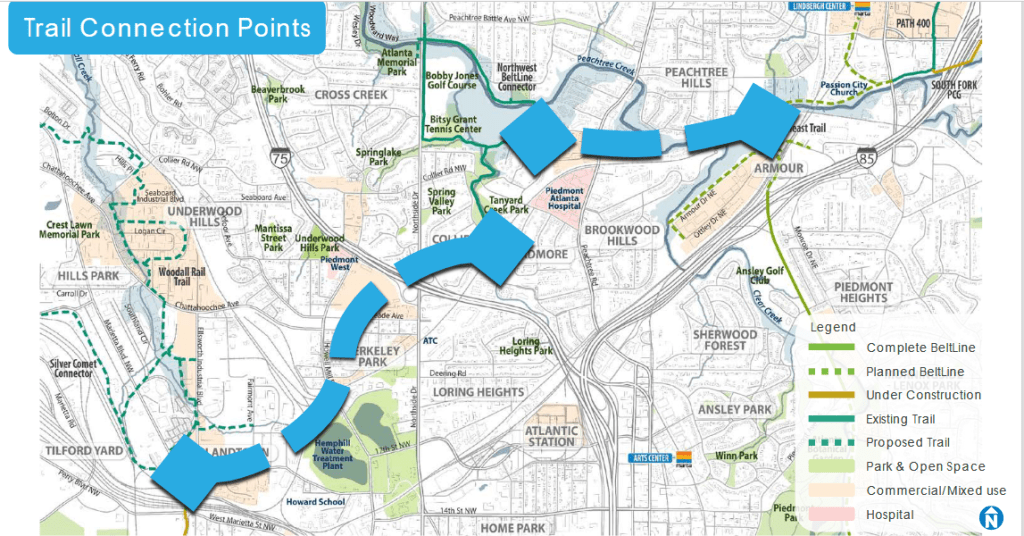A study of the Atlanta BeltLine Northwest Trail’s possible routes through Buckhead and other areas — maybe including tunnels or bridges to bypass highways and railways — should be complete by November and ready for a design phase, planners said at a May 24 virtual meeting.
But they brushed aside many questions about planning for the light-rail transit element of the BeltLine in that area, which will be handled in a separate “sister study” whose timeline remains unclear, though officials say it will begin this spring. Planners in the meeting did say it is likely that the trail and transit parts of the Northwest Trail will have separate routes through much of the corridor.
The Northwest Trail would be a roughly 4.4-mile section of the BeltLine between the Peachtree Creek in Buckhead’s Armour area and Huff Road near the new Westside Park. The Northwest Trail would incorporate the already-built Northside Trail segment in the area of Atlanta Memorial Park and Colonial Homes. In the Armour area, the Northwest Trail would connect with the Northeast Trail, which is partly open along Monroe Drive but has run into complex right of way issues on the Buckhead end.

Virtually the entire Northwest Trail corridor will have similar issues with right of way and transportation corridor conflicts. That’s why Atlanta Beltline Inc., the organization planning and building the linear park, trail and transit system around the city, contracted with the trail-building PATH Foundation to conduct the Northwest Trail study. ABI’s Whitney Fuller said in the virtual meeting that PATH will figure out how “we get through the maze of getting around all the modes of transportation in your geography in order to bring the BeltLine to life.”
Greta deMayo, the PATH Foundation’s executive director, said the study is looking at not only possible routes for the trail, but also cost estimates and the priority of which segments to build in what order. The foundation began the work in late April, she said, and believes design work can begin shortly after the study’s completion. Two more public meetings are planned for August and October. ABI also intends to circulate a survey to gather public ideas on route alignments and connection points.
Laying out a general goal, deMayo said the foundation will aim for a “quality” trail route “that is inclusive, equitable and sustainable.” The two broad strategies will be either “greenway” routes in dedicated, park-like settings, or “sidepath” routes along streets with some type of green space as a buffer.
A major challenge is navigating a trail through the many major roadways and active rail lines in the area. “OK, how do we get across Interstate 75?” asked deMayo as one of the most obvious big questions. She said the foundation wants to avoid any existing roads due to their heavy traffic, “so we’re looking for opportunities to either tunnel under the highway or bridge over the highway.” One specific answer there, she said, could be following the edge of a rail line that runs under the highway already.
But there are many other major streets to cross, like Peachtree Road, Northside Drive, Marietta Boulevard and Howell Mill Road. Safe crossings will be a priority and may include bridges as well as other alternatives, deMayo said. Kim Wilson, ABI’s vice president of design and construction, said that all route-crossing concepts will have a “Plan B and Plan C.”
Much of the area is also heavily developed, meaning many property owners with whom to negotiate right of way for the trail. Wilson said ABI expects to have “multiple alignments that we’re studying” and a process of tweaking the route based on which property owners are willing to sell or offer easements. Wilson said ABI has a “very healthy budget” for the Northwest Trail acquisition and design with revenue expected from the new “special service district” (SSD) within roughly a half-mile of the BeltLine corridor where, starting this fall, property taxes will be increased by 2 mills on commercial and apartment-complex sites.
Many of the questions from the public, including Buckhead’s Collier Hills Civic Association, were about planning for BeltLine transit. ABI officials and deMayo repeatedly said they would not discuss the transit element because it is part of a separate study to come. Wilson said ABI has secured a federal grant for what she described as a “a parallel sister study [on the transit route] that’s going to run in tandem” with the trail planning, but indicated that the consultant for that study has yet to be hired.
However, Wilson and deMayo both said transit is likely to use a largely separate route. “It’s likely in this corridor that transit and trail in some or all of the areas may not run right next to each other,” said Wilson.
The status of the light-rail transit portion of the BeltLine, which would be largely funded and operated by MARTA, has become a point of concern this year. ABI and its political allies declined to include transit funding in the SSD, and shortly after the tax district’s approval, MARTA announced a six-month “feasibility study” about the BeltLine transit component. Such transit advocates as the organization BeltLine Rail Now have expressed concerns that the transit portion might ultimately be changed or removed altogether from the plan, while ABI and MARTA say they remain committed to light rail on the loop. ABI has said its study of the Northwest corridor’s transit element is separate from MARTA’s feasibility study.
The current long-term plan is for the trail portion of the BeltLine’s 22-mile loop around the city to be completed by 2030 and the transit portion by around 2050. For more information, see beltline.org. For the ABI presentation from the May 24 meeting, click here.
